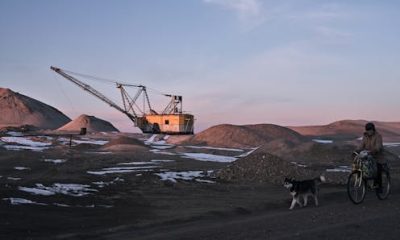
U.S. Special Presidential Envoy for Climate John Kerry and his Chinese counterpart, Xie Zhenhua, had front-row seats at COP28’s final session. Kiara Worth/UN Climate Change via Flickr,, CC BY-NC-SA
Reading down the lengthy final agreement of the COP28 United Nations climate conference held in December 2023, you’ll go a long way before finding a strong, active verb. The lengthy recitation of climate impacts “notes with concern” and occasionally with “significant concern” glaring gaps in countries’ current policies. But while countries volunteered pledges to act, they were less keen to have those pledges framed as binding agreements in the final text.
Reactions to COP28’s conclusion have been understandably mixed. Going into the talks, the world was more on track to avert catastrophic warming than it would have been without the 2015 Paris Agreement, but a long way from where it needs to be.
Even if all the pledges made at COP28 are implemented, the world will still exceed the Paris goal of keeping global warming under 1.5 degrees Celsius (2.7 Fahrenheit) compared to preindustrial temperatures.
The Climate Action Tracker assessment of countries’ pledges at COP28 to reduce emissions shows progress toward the 2030 goal, but a large gap.
Copyright Climate Analytics and NewClimate Institute
Politically, the agreement may have been the best that nations could reach at this time of rising geopolitical tensions and under the leadership of the United Arab Emirates. The UAE is a country of contradictions – a petrostate with renewable energy ambitions, keen to emerge onto the global stage as a green champion, but also accused of colonization tactics in Africa.
Most headlines have focused on the COP28 agreement’s mention of fossil fuels for the first time. The convoluted language called for countries to “contribute” to “transitioning away from fossil fuels,” not the phaseout supported by a majority of countries. With an unprecedented number of energy industry lobbyists on hand, the consensus was described by the most vulnerable countries as a litany of loopholes.
The final agreement was, in large parts, written in a way to secure the future of the natural gas industry. It portrayed natural gas as a necessary bridge fuel while renewable energy expands, an argument that was disproved by the International Energy Agency before COP28. The agreement also furthered the expectation of continued heavy subsidies for carbon capture and storage, which many energy analysts and economists have dismissed as unscalable at a reasonable cost.
Nevertheless, the UAE blasted through some of the old shibboleths of climate negotiation. It broke the polarity of climate finance – the Global South waiting for the Global North to fulfill its promises of public finance – by focusing on private investment and putting tens of billions of dollars of its sovereign wealth into play. It was not able to persuade others to match its generosity, but there will be more pressure in 2024.
So, what should we look for in the coming months?
1. Turning new energy pledges into action
COP28 included significant commitments toward an energy transition away from fossil fuels, including pledges to triple renewable energy capacity, increase energy efficiency and cut methane emissions.
Now it’s up to countries and companies to show progress. That will depend on investments and overcoming supply bottlenecks, as well as new policies and, in the case of methane, standards for imports and exports.
The new Global Cooling Pledge to reduce emissions from cooling by 68% while increasing access to cooling technology is increasingly critical. Demand for cooling is driving up energy demand across the globe, particularly in populous countries hard hit by extreme heat, such as India. Developing technologies that help the billions of people most at risk and improve cold supply chains for food and medicine will require more investment and greater priority from governments.
Watch for more cities to appoint heat czars to spearhead efforts to protect populations from extreme heat, adoption of tree equity plans to increase shade and cooling, and more investment in cooling technologies.
2. Deploying innovations in finance
COP28 saw significant innovation in finance, including the UAE’s announcement of the Alterra Fund – a $30 billion commitment to mobilize private investment in developing countries.
The International Organization of Securities Commissions sent a strong statement in support of corporate sustainability disclosure standards and welcomed corporate integrity standards in the voluntary carbon markets. Look for more countries to add rules around “net-zero emissions” pledges.
3. Putting trade to work for the climate
Linked to finance and investment is trade, which COP28 welcomed to the main stage for the first time.
There are two things to look for in 2024. First, look for the World Trade Organization, International Monetary Fund and the World Bank to align their advice to governments on effective carbon pricing.
Second, while trade and climate negotiators traditionally move in different circles, they will need to work together to ensure the trade system supports climate action. For example, making sure green products and services are not made more expensive than their polluting alternatives.
4. Fixing the carbon markets
2023 was a year of pushback on the voluntary carbon markets, as investigations questioned their effectiveness. COP28’s failure to advance agreements on carbon markets under Article 6 of the Paris Agreement means they will be a focus in 2024.
In this case, no deal was better than a bad deal, but the delay means countries that plan to use carbon markets to meet their net-zero targets are left with uncertainty.
5. Getting more adaptation funding where it’s needed
An agreement on a global goal on adaptation, a collective commitment to build resilience and adaptive capacity across the world, was finally reached, but negotiators left the details to be filled in over the next two years.
To get adaptation funding flowing to where it is most needed, top-down discussions will need to start, including locally led efforts. Look for adaptation to become a much bigger part of countries’ second-generation climate plans to be submitted to the U.N. before COP30.
6. Turning new food and ag pledges into action
A majority of the world’s countries, 159, signed the UAE Declaration on Sustainable Agriculture, Resilient Food Systems and Climate Action. They agreed to include food systems, which contribute a significant percentage of global emissions and which are fundamental to adaptation and resilience, in the next generation of climate plans to be submitted to the U.N.
The pledge was thin on details, however, so how each country turns words into actions will be crucial in 2024.
The next big climate milestones
In late 2024, COP29 will take place in Baku, Azerbaijan – another oil-producing nation. The focus will be on finance. But the next big milestone is in 2025, when governments must submit their future pledges and plans for reducing emissions.
COP30 is to be held in Belen in the Brazilian state of Para – the frontline of Amazon protection. This will bring a focus on nature-based solutions, but from the perspective of the Global South. President Lula da Silva, who is also the host of the G20 in 2024, wants to see change in the international trade and finance system to reflect shifts in the global economy.
COP28 set forth important initiatives but balked at binding commitments. As countries work on their next generation of plans to try to get the world on track to limit global warming, they will have to consider the whole of their economies and cover all greenhouse gases. The world can’t afford to balk twice.
Rachel Kyte is affiliated with VCMI – Voluntary Carbon Markets Integrity Initiative, and Climate Resilience for All CRA
Advertisement

Advertisement
Contact Us
If you would like to place dofollow backlinks in our website or paid content reach out to info@qhubonews.com











